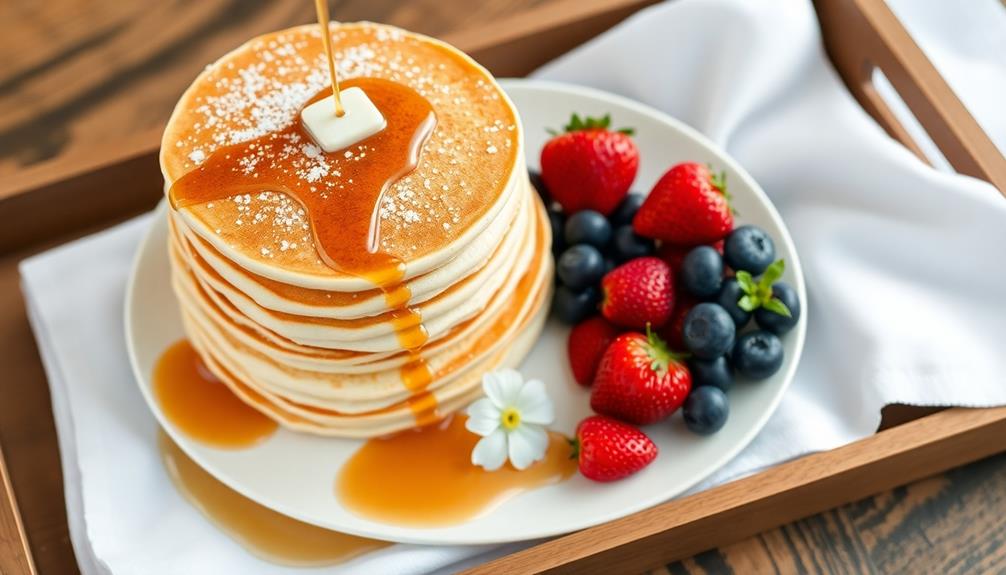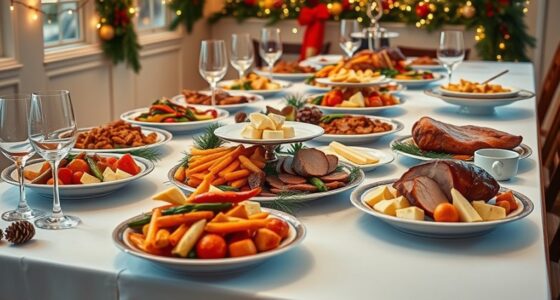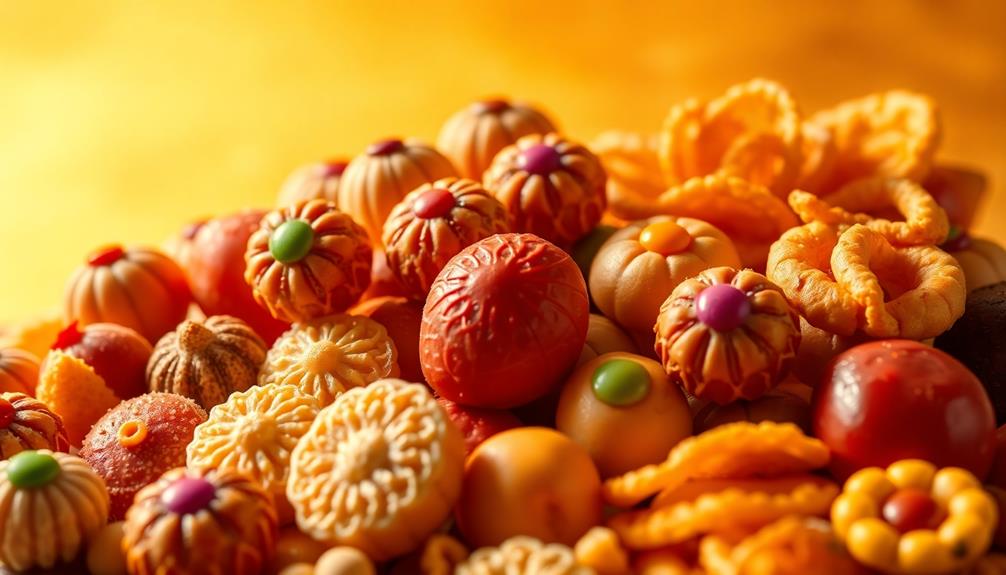Start preparing the night before by chopping vegetables and assembling casseroles. On Thanksgiving morning, begin roasting your turkey 4-5 hours before guests arrive, allowing it to rest 20-30 minutes afterward. Schedule side dishes to finish 30 minutes before mealtime while using warming drawers or slow cookers to keep everything warm. Coordinate oven and stovetop use so all dishes finish at the same time. Keep track and stay organized—more tips will help you master the perfect timeline.
Key Takeaways
- Start roasting the turkey 4-5 hours before guests arrive, allowing time for resting before serving.
- Prepare and pre-cook side dishes and desserts early, coordinating their finish times with the turkey’s rest period.
- Use a detailed schedule to manage oven and stovetop usage, ensuring all dishes are ready simultaneously.
- Set appetizers early and plan final plating and carving to coincide with guest arrival and mealtime.
- Keep dishes warm in warming drawers or slow cookers, and verify readiness shortly before serving for a relaxed celebration.

Thanksgiving, often called Turkey Day, has a rich history rooted in early American traditions. It’s a day dedicated to gratitude, family, and, of course, a feast. When you’re preparing for the big day, managing your dinner preparation and coordinating the guest arrival schedule are key to a smooth celebration. Getting these details right guarantees everyone enjoys the meal and the company without stress.
Thanksgiving is a time for gratitude, family, and a well-planned feast to ensure a joyful celebration.
Your day should start early, ideally the night before, by prepping ingredients that can be made ahead—like chopping vegetables, assembling casseroles, and making dessert. This saves you precious time on Thanksgiving morning. As you plan your dinner preparation, map out a timeline that aligns with your guest arrival schedule. If guests are arriving around noon, you’ll want to have the turkey in the oven early, giving yourself plenty of time to cook it thoroughly while keeping sides warm. A good rule of thumb is to start roasting your turkey 4-5 hours before guests arrive, depending on its size. This way, you’ll have enough time to rest the bird before carving, and you won’t feel rushed.
Coordinate your oven and stovetop usage carefully. Since multiple dishes often need to be cooked simultaneously, plan their cooking times so everything finishes around the same time. Use a countdown to keep track of when to add side dishes to the oven or stove. For example, if your green beans or sweet potatoes need 30 minutes, schedule their start accordingly, so they’re hot and fresh when guests arrive. Also, consider using warming drawers or slow cookers to hold dishes warm without overcooking. Consulting retail hours can help you plan shopping trips early in the day to avoid last-minute rushes.
As guests begin to arrive, your focus shifts to welcoming them and managing the flow of food. Keep the guest arrival schedule flexible but communicate clearly with your guests about when the main meal will be served. This helps prevent everyone from hovering in the kitchen or feeling rushed. Set out appetizers early, so guests have something to nibble on while you finish the final touches. As the clock ticks closer to mealtime, check your dinner preparation list to ensure everything is ready—turkey carved, sides plated, beverages poured. Being organized keeps the atmosphere relaxed and enjoyable.
Finally, as everyone seats themselves, you’ll feel confident knowing your timing and preparations kept the day running smoothly. A well-planned schedule makes all the difference—allowing you to focus on creating memories, not just managing deadlines. With thoughtful coordination of dinner preparation and guest arrival timing, your Thanksgiving celebration will be as warm and inviting as the feast itself.
Frequently Asked Questions
What Are the Best Side Dishes to Prepare Ahead of Time?
You should prepare make ahead casseroles and chilled salads to save time on Turkey Day. Make casseroles like green bean or sweet potato a day before, then just reheat. Chilled salads, such as cranberry apple or pasta salads, taste even better after sitting in the fridge. These dishes free up oven space and reduce last-minute stress, letting you enjoy the celebration with your loved ones.
How Can I Keep the Turkey Warm Without Drying It Out?
Think of your turkey like a vintage iPhone—best kept warm and protected. To keep it moist, tent it with foil and use oven insulation, which acts like a cozy blanket. Meanwhile, warm the gravy separately, perhaps on a low simmer, to prevent drying out. This way, your turkey stays juicy and flavorful, ready to serve without losing its tenderness or succumbing to the dreaded dryness.
What Are Safe Internal Temperatures for Different Types of Poultry?
You should use cooking thermometers to guarantee poultry safety. For whole poultry, like turkey and chicken, cook until the internal temperature reaches 165°F. Duck and other game birds also need to hit 165°F. For safety, always use a reliable thermometer to check the thickest part of the meat. Properly cooking poultry to these temperatures prevents harmful bacteria, ensuring your meal is both delicious and safe to eat.
How Do I Coordinate Multiple Dishes Cooking Simultaneously?
You’ve got your hands full, but don’t let it ruffle your feathers. Use timing strategies by starting dishes with longer cook times first and multitasking where possible. Prioritize dishes that need a specific temperature or time, and keep an eye on your oven and stove. Stagger the finishing times so everything’s hot and ready at once. With a little planning, you’ll be the host with the most, pulling off a perfect feast.
What Are Quick Tips for Last-Minute Meal Adjustments?
When making last-minute meal adjustments, keep calm and focus on recipe substitutions to save time. For example, swap out fresh herbs for dried ones or use pre-cut vegetables. If timing’s tight, adjust cooking times slightly or delay certain dishes to better align with your schedule. Always taste as you go, and don’t hesitate to simplify a recipe if needed, ensuring everything comes together smoothly for a stress-free holiday feast.
Conclusion
As you carve the perfectly cooked turkey, the sizzling sounds fade into a warm, fragrant silence. The table, once chaotic with preparation, now feels calm and inviting. Amid the laughter and clinking glasses, the chaos of the day transforms into a peaceful moment of gratitude. That tender, golden bird is more than just a meal—it’s the centerpiece of memories, proof that even the busiest days can end with a simple, delicious reward.









